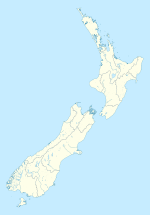Gore, New Zealand
Gore is a town, surrounding borough, and district in the Southland region of the South Island of New Zealand.
The Gore District has a land area of 1,251.62 km² (483.25 sq mi) and a 2006 census population of 12,108 usual residents.
The town of Gore is 64 km northeast of Invercargill and 70 km west of Balclutha—Dunedin and Invercargill are the nearest cities. The urban area estimated resident population at July 2007 was 9,770, the second largest in Southland.[1] Gore is a service town for the surrounding farm communities.
Originally known as Longford, Gore was renamed after Sir Thomas Gore Browne, an early Governor of New Zealand. It is divided by the Mataura River into Gore and East Gore, the majority of the town being situated on the western banks of the river. The Main South Line railway from Dunedin to Invercargill runs through the town, though passenger services ceased in 2003. Gore was once a busy railway junction; the Waimea Plains Railway ran west to connect with the Kingston Branch in Lumsden, while the Waikaka Branch connected with the Main South Line nearby in McNab. One of New Zealand's most famous preserved trains is the Kingston Flyer, which takes its name from a passenger express that once ran between Kingston and Gore.
Gore is known in New Zealand folklore as the home of Hokonui moonshine. During the days of prohibition, the Hokonui Hills to the west of the town gained a reputation for the production of illicit alcohol.

Gore's local radio station Hokonui Gold broadcasts from within the town.
Gore is well known for its connection with Country and Western music, with the annual New Zealand country music awards being held in the town. Gore has a sister city relationship with Tamworth, New South Wales, the "Country Music Capital of Australia".
The former East Gore Presbyterian Church is one of the two remaining wooden Gothic churches designed by the eminent architect R.A. Lawson.[2] Built in 1881 and registered by the New Zealand Historic Places Trust, the main building is currently used as a performance and lecture theatre and the hall, built later, is used as a studio and flat for visiting artists, the latter including the bedroom furniture from the Royal Suite commissioned for the Queen's Royal Tour to Southland in 1954.[3]
References
- ^ "Subnational Population Estimates: At 30 June 2007" (XLS). Statistics New Zealand. Retrieved 2007-12-01.
- ^ J.F. McArthur (1981). From the Kirk on the Hill. Gore Publishing Company.
- ^ "Visiting Artist Programme with New Zealand" (PDF). Hazelhurst Regional Gallery & Arts Centre, Sutherland Shire Council. Autumn 2004.

